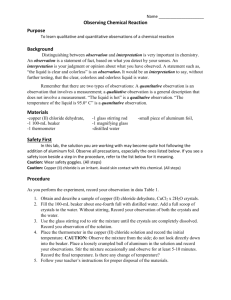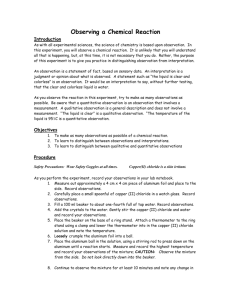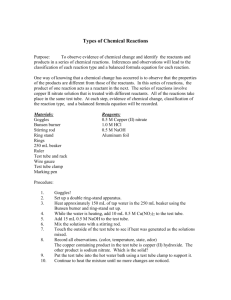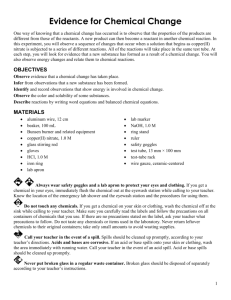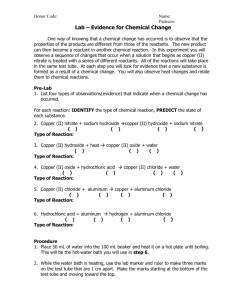EVIDENCE FOR A CHEMICAL REACTION (13 points) (page 1 of 2)
advertisement
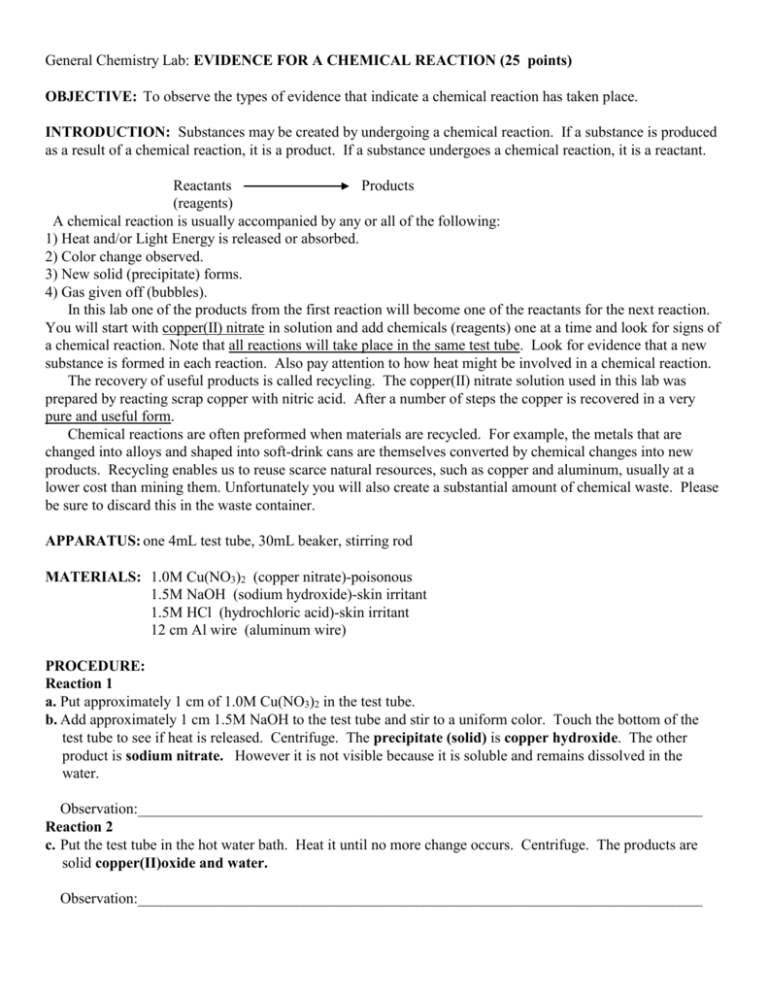
General Chemistry Lab: EVIDENCE FOR A CHEMICAL REACTION (25 points) OBJECTIVE: To observe the types of evidence that indicate a chemical reaction has taken place. INTRODUCTION: Substances may be created by undergoing a chemical reaction. If a substance is produced as a result of a chemical reaction, it is a product. If a substance undergoes a chemical reaction, it is a reactant. Reactants Products (reagents) A chemical reaction is usually accompanied by any or all of the following: 1) Heat and/or Light Energy is released or absorbed. 2) Color change observed. 3) New solid (precipitate) forms. 4) Gas given off (bubbles). In this lab one of the products from the first reaction will become one of the reactants for the next reaction. You will start with copper(II) nitrate in solution and add chemicals (reagents) one at a time and look for signs of a chemical reaction. Note that all reactions will take place in the same test tube. Look for evidence that a new substance is formed in each reaction. Also pay attention to how heat might be involved in a chemical reaction. The recovery of useful products is called recycling. The copper(II) nitrate solution used in this lab was prepared by reacting scrap copper with nitric acid. After a number of steps the copper is recovered in a very pure and useful form. Chemical reactions are often preformed when materials are recycled. For example, the metals that are changed into alloys and shaped into soft-drink cans are themselves converted by chemical changes into new products. Recycling enables us to reuse scarce natural resources, such as copper and aluminum, usually at a lower cost than mining them. Unfortunately you will also create a substantial amount of chemical waste. Please be sure to discard this in the waste container. APPARATUS: one 4mL test tube, 30mL beaker, stirring rod MATERIALS: 1.0M Cu(NO3)2 (copper nitrate)-poisonous 1.5M NaOH (sodium hydroxide)-skin irritant 1.5M HCl (hydrochloric acid)-skin irritant 12 cm Al wire (aluminum wire) PROCEDURE: Reaction 1 a. Put approximately 1 cm of 1.0M Cu(NO3)2 in the test tube. b. Add approximately 1 cm 1.5M NaOH to the test tube and stir to a uniform color. Touch the bottom of the test tube to see if heat is released. Centrifuge. The precipitate (solid) is copper hydroxide. The other product is sodium nitrate. However it is not visible because it is soluble and remains dissolved in the water. Observation:___________________________________________________________________________ Reaction 2 c. Put the test tube in the hot water bath. Heat it until no more change occurs. Centrifuge. The products are solid copper(II)oxide and water. Observation:___________________________________________________________________________ Reaction 3 d. Pour off the liquid layer into the waste judge. Add approximately 2 cm of 1.5M HCl to the copper(II)oxide and stir. The products are copper(II)chloride and water. Observation:___________________________________________________________________________ Reaction 4 and 5 6. Fold a 12 cm Al wire in half and add it to the copper(II)chloride. Allow the aluminum wire to remain in the solution until the reaction stops. This will take some time. Touch the bottom of the test tube to check for a temperature change. Remove the wire and centrifuge. TWO reactions have taken place. Copper(II)chloride and aluminum produce solid copper and aluminum chloride. Only the copper should be visible. The aluminum chloride is soluble and stays dissolved in the water. The aluminum also reacts with the hydrochloric acid to form hydrogen gas and aluminum chloride. Observation:___________________________________________________________________________ 7. Dispose all solids and the liquids in the waste jug. Rinse off all equipment and wash your hands before you leave the lab. Data Table Reaction Number 1 copper(II)nitrate+ sodium hydroxide 2 copper(II)hydroxide+ (HEAT) 3 copper(II)oxide+ hydrochloric acid 4 aluminum+ copper(II)chloride 5 aluminum+ hydrochloric acid Reaction describe describe the the gas liquid or solid *C/C – clear and colorless QUESTIONS: 1. Describe two ways that a chemical reaction can be started. (1)_________________________ (2)__________________________ 2. In what two ways is heat involved in chemical change? (1)________________________ (2)________________________ 4. In the last test tube how the aluminum chloride is dissolved in the water . How can it be recovered? 5. List the Four indications that a chemical reaction has occurred. (1)_________________________________________________ (2)_________________________________________________ (3)_________________________________________________ (4)_________________________________________________ 6. Describe an advantage of recycling metals as was done in this lab. 7. Describe a disadvantage of recycling metals as was done in this lab.




